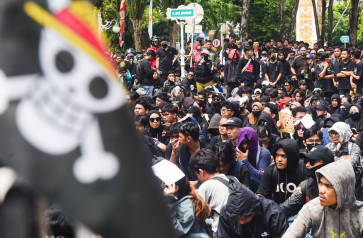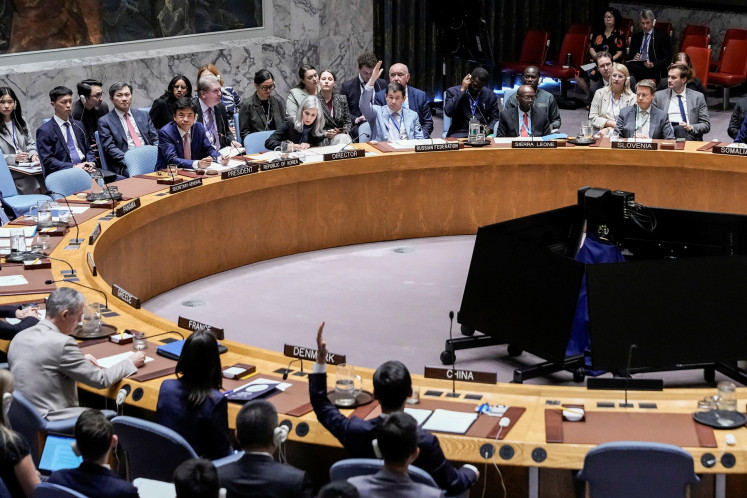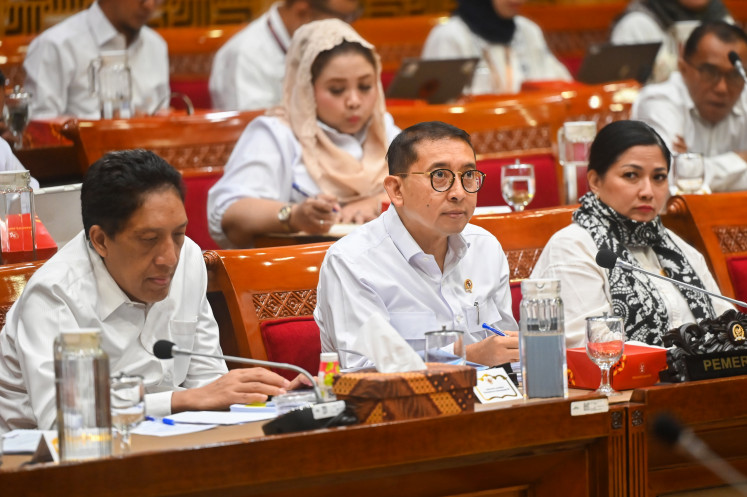Popular Reads
Top Results
Can't find what you're looking for?
View all search resultsPopular Reads
Top Results
Can't find what you're looking for?
View all search resultsAnies joins hands with ministries to upgrade city transportation
Anies Baswedan (JP/Rafaela Chandra)The Jakarta administration is working with the State-Owned Enterprises Ministry and the Transportation Ministry to integrate all modes of transportation across the city, including routes and payment systems, to help ease customers’ journeys
Change text size
Gift Premium Articles
to Anyone
Anies Baswedan (JP/Rafaela Chandra)
The Jakarta administration is working with the State-Owned Enterprises Ministry and the Transportation Ministry to integrate all modes of transportation across the city, including routes and payment systems, to help ease customers’ journeys.
It is hoped that an improvement in facilities will attract more passengers with commuters in Greater Jakarta shifting from private vehicles to public transportation and, thus, reducing road traffic.
For that purpose, the city administration and the ministries have set up a joint venture named PT Moda Integrasi Transportasi Jabodetabek.
Mass rapid transit (MRT) operator PT MRT Jakarta, 99 percent owned by the Jakarta administration, will have a 51 percent stake in the joint venture with the remaining 49 percent being held by state-owned railway operator PT KAI.
Directors of both operators signed the agreement on Friday.
The joint venture company will integrate Transjakarta buses, the MRT, Jakarta LRT, Greater Jakarta LRT and Commuter Line services.
“There will be one system that integrates the routes and fares for all public transportation services,” Jakarta Governor Anies Baswedan said after the agreement.
He expressed his hope that this effort would provide more affordable and highly accessible public transportation services. “Now that these operators fall under one joint venture company, the service management and development will be more efficient. Efficiency could reduce costs,” Anies said.
For a starter, the joint venture company will redesign four stations: Tanah Abang, Juanda, Pasar Senen and Sudirman stations. The goal is to control the flow of people, vehicles and reduce congestion at the station areas. Construction will start soon and be completed in March, according to Anies.
“In March, the public will see changes at those four stations,” he said, adding that the company planned to redesign and manage 72 train stations, including the airport train and the Commuter Line stations.
Jakarta has been battling congestion for decades as residents of Greater Jakarta commute to and from the capital city each day, making 88 million daily trips — both in private vehicles and on public transportation — in 2018, a massive increase from 47.5 million trips per day in 2015.
The city administration has made several innovations to reduce traffic by providing commuters with more public transportation options. In 2019, the Jakarta MRT and LRT started their operations. Several MRT and LRT stations are connected with angkot (public minivan) and Transjakarta bus routes under the Jak Lingko scheme.
The MRT saw an increase to 84,000 passengers from the initial target of 65,000 passengers a day after the integration.
Meanwhile, Transjakarta recorded an average of 700,000 passengers daily in 2019, increasing from 300,000 passengers in 2017 before the Jak Lingko program was started.
The program allows passengers to ride Transjakarta buses, angkot and medium-sized buses commonly known as Kopaja and Metro Mini buses participating in the program for one flat fare of Rp 5,000 (36 US cents) per three hours. The MRT and LRT services have yet to be included in the flat-fare scheme.
More integration is needed to improve the convenience and punctuality in moving from one place to another, by easy payment and transfer between different transportation modes. This is important as the city plans to develop transit-oriented areas with the development of high-rise apartments near railway stations so that public transportation and facilities can be easily accessed on foot.
“However, the integration attempt will not be effective without coordination between each transportation operator,” Transportation Minister Budi Karya Sumadi said.
The director of the Institute for Transportation and Development Policy (ITDP) Southeast Asia, Faela Sufa, said that the station redesign should also result in closer access to Transjakarta stops from the railway stations.
Moreover, the joint venture company also needs to integrate all 5,499 angkot and 2,000 medium-sized buses, currently only 1,160 angkot and 420 medium-sized buses participate in the integrated Jak Lingko program.
Another suggestion is to apply a one-payment scheme in which commuters can use the same payment for all public transportation services and change vehicles without paying in each vehicle.
Faela also urged the administration to assist the integration system with policies that will persuade commuters to use public transportation, since the number of private vehicle users keeps increasing despite the greater choices of public transportation.
In 2019, only 25 percent of commuters used public transportation, according to Jabodetabek Urban Transportation Policy Integration (JUTPI) data. Motorbike use was highest with 51 percent and car use stood at 24 percent. Anies is aiming for 60 percent public transportation use by 2030.
“Look at Singapore. There, people are forced to use public transportation because the growth of private car use is constrained,” Faela said.
She mentioned two policies that would force people to shift from private to public transportation. The first is parking restrictions. “If the buildings in Jakarta stop providing parking spaces, people will have no choice but to use public transportation services to get to the building,” said Faela.
The second is an electronic road pricing scheme, in which vehicle owners are charged for entering certain roads. The scheme was first proposed in 2005 but has yet to be realized until now, the tender process has been long delayed as a result of uncertainty surrounding administration support for the scheme, public policy expert from University of Indonesia Agus Pambagio said.
Jakarta currently imposes an odd-even license plate policy to limit the use of private vehicles. But Faela said electronic road pricing would be more effective as the system was technology-based. (aly)










